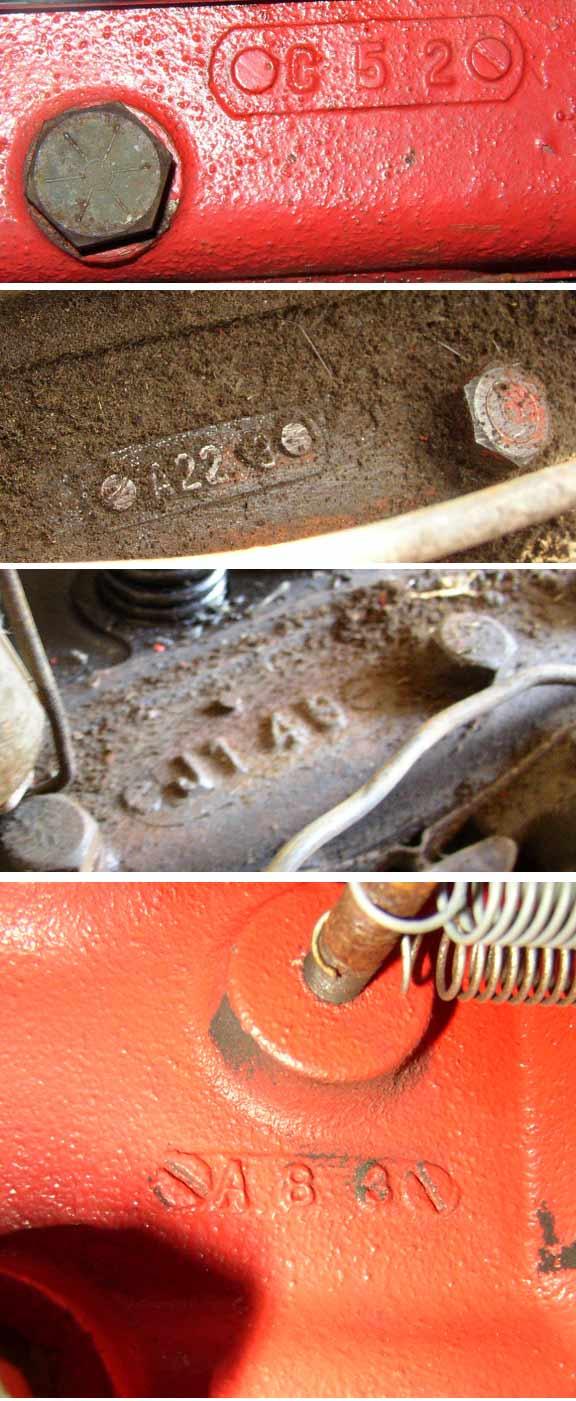This subject came up on our oldGMC boards and I thought it might be helpful to inliners members who want to know where to search for GMC 302 engines.
The 302 is a popular upgrade for many enthusiasts so here's a couple of clues that might help in the search for one:
MILITARY 302sThe 302 was available from GMC in Military M135, six wheel "deuce and half" 5000# trucks from '53-60. These trucks were equipped with a HydraMatic drive and the engines were military spec'd to run on a snorkle underwater so they are completely sealed. Electric fuel pump too. While the block is bascially the same, modifications need be done to use a Military block in most civilian applications. The intake has a 4 bolt carb flange. The exhaust is the same as civlian models.
You will often find these trucks in forest service, fire service, boy scouts, and other quasi government agencies retired from their second life...the first life being a military M135, the second life being a plow truck, brush truck, water truck, etc.
CIVILIAN 302sThe 302 was available in the following civilian model trucks:
1952-1954 450 (Conventional) and F450 (Cab Over)series
1954 M450 series (HydraMatic)
1952-1954 F470 (Cab Over) and 470 (Conventional)
1954 M470 series (HydraMatic)
1959 S370, M370, & 370 series as an optional engine
1955-1959 450 (Conventional), F450 (COE), FM450 (HydraMatic COE), S450 (School Bus)
1955-1959 500, M500, MW500 (HydraMatic w/tandem drive), W500 (tandem drive), and F500 (COE)
In civilian trucks, it is usually a bit easier to identify by serial number on ID plate. The two digits on the id plate following the series number are going to be "30".
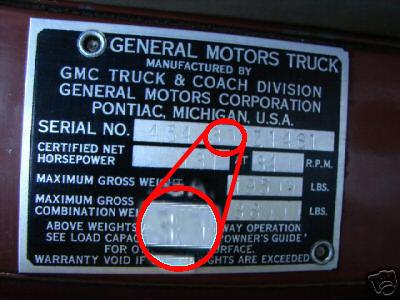
For example, a serial number of 454 30 Z 1481 would be a 450 series, the 3 indicates wheelbase, and the 30 indicates the engine to be a 302.
In these applications it is also best to 3 way check this: Civilian GMC trucks with 302 all had a second ID plate on the back of the gloebox door which showed all the equipment specs and it too should state 302 - that's the 2nd check. The 3rd check is to see what number is embossed on the motor adjacent to the distributor. The first three numbers of that number should be 302. They may be preceeded with a letter indicating how the crank and rod journals were cut/spec'd.
Date coding is another thing that is helpful on these motors.
Here is a copy of a post I did on this topic concerning a 302 I'm working on right now and others may benefit from some of this information. If it is too much to post here just let me know and I can delete any or all of this thread, but I thought others might find it helpful.
A lot of us have gotten into our motors and have collected some prospective spares, and I thought it might be interesting to discuss some of the things we look for when prowling for a project or replacement motor.
The Service Manager and I were fortunate enough to have found and recovered a couple of 302s and bunch of spare parts for 302s and 270s. The 302 I got came out of the '54 COE. It was totally buried in 50 years of grease cake and other than scraping the pad adjacent to the distributor to confirm it was a 302, and pulling the dip stick to make sure the crankcase wasn't full of water, I did very little but remove it and park it in my shop.
Over past two weeks, I've had a small army of scrapers lying next to it and I've been scratching on it every free chance I've had to clean it up enough that I felt it was safe to begin disassembly without fear of putting cake/rust/schmega junk in the motor during the breakdown period.
I have been using a scraper and screw driver for the most part, but it's been VERY slow going so I decided I needed to up the ante. I went to Sears yesterday and picked up a pack of three scrapers which have totally changed the level of effort required on my end of the deal. These scrapers are worth their weight in gold as far as I'm concerned.
So back to the topic: What clues to look for when searching for a prospective motor.
The basic things I encourage everyone to check prior to considering any junkyard or junked engine are as follows:
1) AntiFreeze/Freeze Plugs - check all the visible freeze plugs for any sign they have popped, adn see if there's any antifreeze in the motor/radiator. Is the block drain plug open/closed/in place?
2) Oil - check the oil for any indications of water or contamination
3) Was the hood open or closed on the truck? An open hood can allow water to enter the engine through the rocker vents (*if so equipped) and it will end up in the oil pan after dripping through the oil passages.
4) Broken or obvious signs of why this motor is in the junkyard to start with; is the truck crashed or is there some obvious failure that might have led to its being put in the yard?
5) Casting numbers: ALWAYS check the casting numbers on the head and block to make sure the engine is what you think it is.
Further clues....
Andy has a great post in the the Hall of Fame on how to read date codes. I found that the 302 from the '54 COE had a 1956 date code. How is that possible? It's possible because it's a replacement engine.
First a close exam of the numbers on the pad adjacent to the distributor revealed that the block at least was a replacement block; it did not begin with a letter code (customary on original engines in my experience) and the font/type set of the numbers following 302 are different and bigger clearly showing the engine was re-stamped with the original serial number:
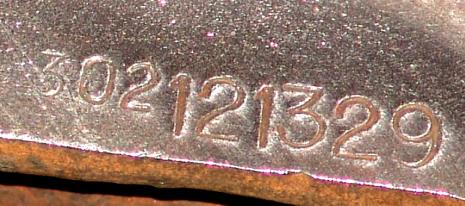
OK, so now I know the engine was re-numbered and the block replaced. The intake/exhaust manifold date codes are '54, but the head and block show 1956. Here's the date code off the block. It is J 25 6 which corrolates to October 25 1956

Here's the date code on the head which read G 17 6 and corrolates to July 17, 1956. So that tells me that both the head and block were replaced, but the manifolds were apparently re-used.
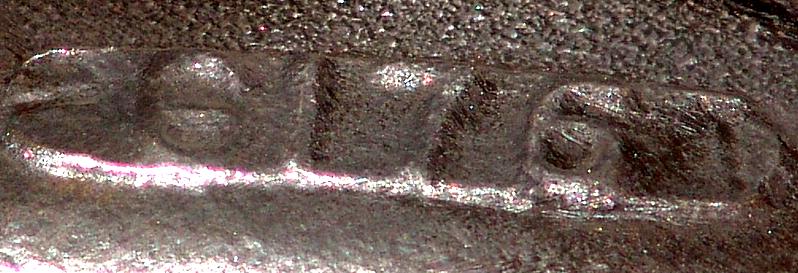
Here's where I'm pulling these numbers from for anyone interested:
First, the manifold side of the engine:
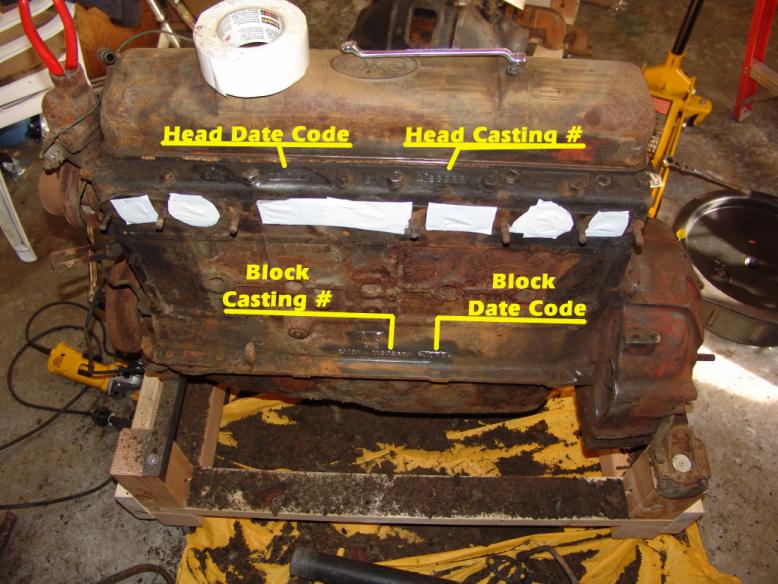
All of these clues were helpful in determining if the likelihood of a useable motor is there. I have still not yet opened this engine up to see if something catastrophic happened and took it out of service, but I am pretty confident that this one should be ok.
Only time will tell and I have still a lot more cleaning on this before I'm ready to open it up and see the inside because I want to go straight to a rebuild on this one and it's a lot easier to clean the outside when engine is still sealed and you don't risk dropping a lot of metallic crud into it.
Lastly, here is another helpful bit of information on reading date codes from Andy Siechen, our GMC Engine Technical Advisor:
Several people have asked here and through my email about how to tell what year an engine really is. Here goes:
I attached a picture of what is used to determine the casting date of the
GMC engine blocks and heads.
The first digit is always a letter of the alphabet A-L. A=January,
B=Febuary, C=March etc, etc all the way to L=December.
The next digit is a number 1-31 which is the day of the month.
The last digit is always a single number and represents the year of the casting. For example, the one
casting date in the picture would read: March 5th, 1952.
What gets tricky is that the "2" for the year could mean 1942, 1952 or
1962. In this case, you have to look at the casting number and/or engine
model to narrow this down.
The example in the picture is the 302 head that's in my truck. 302's were
only made from 1952-1959 so the "2" can only mean 1952. Same thing with
the 270, the casting number of the heads and blocks changed over the years
so this has to be used along with the date code to pinpoint the year if
there are multiple possibilities.
The date code casting for the block is usually on the same side if the
block as the casting number. The cylinder head location is usually outside
the valve cover near the center. Some of the later 270 and 302 heads had
all the casting numbers and date castings under the valve cover down near
where the pushrods come through.
The raised area with the date almost looks like a small plate
attached with two screws and they are often mistaken for something that can be removed. They actually are part of the casting. The
slotted screw impression is there because that's likely what they used to
hold the tag on the inside of the mold when the casting was poured.
Other GM products use the same method so you may see the same thing on Chevrolets, Buicks etc, etc.
